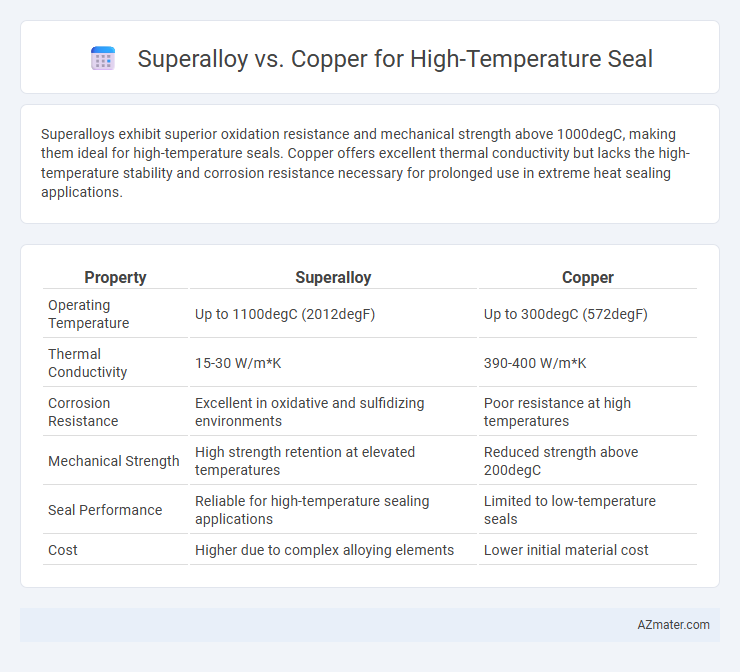Superalloys exhibit superior oxidation resistance and mechanical strength above 1000degC, making them ideal for high-temperature seals. Copper offers excellent thermal conductivity but lacks the high-temperature stability and corrosion resistance necessary for prolonged use in extreme heat sealing applications.
Table of Comparison
| Property | Superalloy | Copper |
|---|---|---|
| Operating Temperature | Up to 1100degC (2012degF) | Up to 300degC (572degF) |
| Thermal Conductivity | 15-30 W/m*K | 390-400 W/m*K |
| Corrosion Resistance | Excellent in oxidative and sulfidizing environments | Poor resistance at high temperatures |
| Mechanical Strength | High strength retention at elevated temperatures | Reduced strength above 200degC |
| Seal Performance | Reliable for high-temperature sealing applications | Limited to low-temperature seals |
| Cost | Higher due to complex alloying elements | Lower initial material cost |
Introduction to High-Temperature Seal Materials
High-temperature seal materials require exceptional thermal stability, corrosion resistance, and mechanical strength to ensure reliable performance in extreme environments such as gas turbines and aerospace engines. Superalloys, typically nickel or cobalt-based, offer superior oxidation resistance and strength retention at elevated temperatures compared to copper, which excels in thermal and electrical conductivity but lacks long-term high-temperature durability. Selecting the appropriate material hinges on balancing factors like thermal expansion, chemical stability, and operational temperature to optimize seal integrity and lifespan.
Overview of Superalloys and Copper
Superalloys, primarily composed of nickel, cobalt, or iron, exhibit exceptional mechanical strength, resistance to thermal creep deformation, and oxidation stability at high temperatures, making them ideal for high-temperature seals in aerospace and power generation. Copper offers excellent thermal and electrical conductivity but has lower melting points and reduced resistance to oxidation and creep under extreme heat compared to superalloys. High-temperature sealing applications benefit from superalloys' durability and stability, while copper is favored in moderate temperature environments requiring efficient heat dissipation.
Thermal Resistance: Superalloy vs Copper
Superalloys exhibit superior thermal resistance compared to copper, maintaining strength and oxidation resistance at temperatures exceeding 1000degC, while copper typically begins to soften and lose mechanical integrity above 400degC. The high melting point and stable oxide layer formation in superalloys enable prolonged performance in extreme thermal environments. Copper, despite excellent thermal conductivity, is less suitable for high-temperature seals due to rapid degradation and reduced dimensional stability under thermal stress.
Mechanical Strength at Elevated Temperatures
Superalloys exhibit superior mechanical strength at elevated temperatures compared to copper, maintaining structural integrity and resistance to deformation above 700degC. Copper, while highly conductive, significantly loses strength and creeps under high thermal stress, limiting its use in high-temperature sealing applications. This makes superalloys the preferred choice for seals requiring durability and reliability in extreme thermal environments.
Oxidation and Corrosion Resistance
Superalloys exhibit superior oxidation and corrosion resistance compared to copper, making them ideal for high-temperature seal applications in harsh environments. Their complex compositions, typically including elements like chromium, cobalt, and nickel, form stable oxide layers that prevent further degradation and maintain integrity under thermal stress. Copper, while having excellent thermal conductivity, rapidly oxidizes and corrodes at elevated temperatures, leading to seal failure and reduced service life.
Seal Performance Under Thermal Cycling
Superalloys exhibit superior dimensional stability and oxidation resistance compared to copper in high-temperature seal applications, maintaining tight sealing performance under repeated thermal cycling. Copper, while highly conductive, tends to soften and undergo creep at elevated temperatures, leading to seal degradation and potential failure. The enhanced mechanical strength and corrosion resistance of superalloys ensure prolonged seal integrity and reduced maintenance in extreme thermal environments.
Manufacturability and Machinability
Superalloys exhibit superior high-temperature strength and oxidation resistance compared to copper, making them ideal for manufacturing seals subjected to extreme thermal environments. Machinability of superalloys is challenging due to their hardness and work-hardening behavior, requiring specialized tooling and machining processes, whereas copper offers excellent machinability with ease of cutting and forming, reducing manufacturing time and costs. The choice between superalloys and copper seals depends on balancing manufacturability constraints against the required high-temperature performance and durability.
Cost and Economic Considerations
Superalloys exhibit superior high-temperature performance and oxidation resistance compared to copper, justifying their higher initial cost in critical seal applications exposed to extreme heat. Copper, while more economically attractive due to its lower material and manufacturing expenses, requires frequent replacement and maintenance in high-temperature environments, leading to increased long-term operational costs. Evaluating lifecycle expenses reveals superalloys often provide better overall economic value despite the upfront investment, especially in industries prioritizing durability and reliability under thermal stress.
Typical Applications in Industry
Superalloys excel in high-temperature seals used in gas turbines, aerospace engines, and power generation due to their exceptional strength and oxidation resistance above 700degC. Copper finds typical applications in electronic vacuum seals and heat exchangers where excellent thermal conductivity and moderate temperature resistance up to 400degC are critical. Industries such as chemical processing and automotive benefit from superalloys for durability under thermal cycling, while copper seals are preferred in electrical and refrigeration systems for efficient heat dissipation.
Selecting the Optimal Material for High-Temperature Seals
Superalloys offer exceptional oxidation resistance, mechanical strength, and thermal stability at temperatures exceeding 1000degC, making them ideal for high-temperature seal applications where durability is critical. Copper provides excellent thermal conductivity and is cost-effective but suffers from lower melting points and reduced mechanical strength at elevated temperatures, limiting its use in extreme thermal environments. Selecting the optimal material depends on balancing thermal performance, mechanical integrity, and operating environment, with superalloys preferred for demanding high-temperature seals and copper favored for moderate temperature applications requiring thermal conductivity.

Infographic: Superalloy vs Copper for High-Temperature Seal
 azmater.com
azmater.com